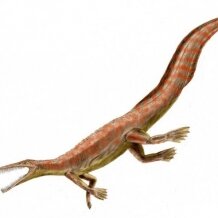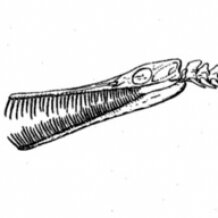Topic: Crustacean-trapping teeth in mesosaurs and crabeater seals
The multi-lobed post-canines of Lobodon carcinophagus are a functional analogue to the long, thin cage-like teeth of Mesosaurus, as both cage and prevent the escape of small crustacean prey.
 A group of Early Permian (320 - 280Ma) marine reptiles known as mesosaurs had remarkable dentition, comprising a large number of long, slender, pointed teeth shallowly implanted in the upper jaw (premaxilla and maxillary bone) and lower jaw (dentary bone), leaving very little space between teeth when the jaws were closed. Teeth were all similar in form (homodont), but tooth orientation varied from vertical at the back of the mouth to more outward-pointing at the front, and the tip of each tooth curved inwards towards the palate.
A group of Early Permian (320 - 280Ma) marine reptiles known as mesosaurs had remarkable dentition, comprising a large number of long, slender, pointed teeth shallowly implanted in the upper jaw (premaxilla and maxillary bone) and lower jaw (dentary bone), leaving very little space between teeth when the jaws were closed. Teeth were all similar in form (homodont), but tooth orientation varied from vertical at the back of the mouth to more outward-pointing at the front, and the tip of each tooth curved inwards towards the palate.  Mesosaurs (e.g. Mesosaurus tenuidens, Stereosternum tumidum) were gharial-like in having a long, narrow snout and plesiosaur-like in having a compressed, lightly-built skull and a long neck - optimally designed for reducing drag and pitching of the head when in motion. The mysterious dentition of Mesosaurus was initially proposed to be an adaptation to filter-feeding, but closer examination of how teeth interlocked in life has shown this to be untrue. The very long, slender teeth served to entrap very small nektonic animals (e.g. crustaceans), effectively 'caging' them in the mouth before swallowing them whole. This interpretation is further supported by the fact that mesosaur teeth show little evidence of physical wear, as they were not used for grasping or chewing, and each tooth was thin, long (approximately 3cm) and yet only weakly attached to the jaw bone, indicating lack of a mechanical role in prey acquisition.
Mesosaurs (e.g. Mesosaurus tenuidens, Stereosternum tumidum) were gharial-like in having a long, narrow snout and plesiosaur-like in having a compressed, lightly-built skull and a long neck - optimally designed for reducing drag and pitching of the head when in motion. The mysterious dentition of Mesosaurus was initially proposed to be an adaptation to filter-feeding, but closer examination of how teeth interlocked in life has shown this to be untrue. The very long, slender teeth served to entrap very small nektonic animals (e.g. crustaceans), effectively 'caging' them in the mouth before swallowing them whole. This interpretation is further supported by the fact that mesosaur teeth show little evidence of physical wear, as they were not used for grasping or chewing, and each tooth was thin, long (approximately 3cm) and yet only weakly attached to the jaw bone, indicating lack of a mechanical role in prey acquisition.  Mesosaurs are primitive, Palaeozoic members of the 'anapsid' reptiles (or 'para-reptiles'), inhabiting the so-called 'Mesosaurus Sea' prior to the Mesozoic radiation of 'diapsid' reptiles (archosaurs and lepidosaurs) and 'synapsids' (mammals and their relatives). The Mesosaurus Sea was rich in notocaridid crustaceans, a Palaeozoic version of 'krill' that abound in Antarctic seas today. These small (a few cm long) crustaceans were very probably the primary, if not exclusive, component of the mesosaur diet.
Mesosaurs are primitive, Palaeozoic members of the 'anapsid' reptiles (or 'para-reptiles'), inhabiting the so-called 'Mesosaurus Sea' prior to the Mesozoic radiation of 'diapsid' reptiles (archosaurs and lepidosaurs) and 'synapsids' (mammals and their relatives). The Mesosaurus Sea was rich in notocaridid crustaceans, a Palaeozoic version of 'krill' that abound in Antarctic seas today. These small (a few cm long) crustaceans were very probably the primary, if not exclusive, component of the mesosaur diet.
 Mesosaur dentition appears to be unique in both form and function within the reptiles, and yet it arguably has a convergent counterpart in the highly complex post-canine teeth of the crabeater seal Lobodon carcinophagus. This unusual marine mammal is a cetacean that lives in the pack-ice zone of Antarctica, feeding not on crabs (as its name would suggest) but on Antarctic krill (Euphausia superba). Behind two pairs of canine teeth, Lobodon possesses five pairs of strangely shaped post-canines; each cusp is covered in multiple deep lobes,
Mesosaur dentition appears to be unique in both form and function within the reptiles, and yet it arguably has a convergent counterpart in the highly complex post-canine teeth of the crabeater seal Lobodon carcinophagus. This unusual marine mammal is a cetacean that lives in the pack-ice zone of Antarctica, feeding not on crabs (as its name would suggest) but on Antarctic krill (Euphausia superba). Behind two pairs of canine teeth, Lobodon possesses five pairs of strangely shaped post-canines; each cusp is covered in multiple deep lobes,  and the teeth of upper and lower jaws closely interlock save for the gaps between lobes on opposed teeth. This dentition provides an ideal prey entrapment mechanism, as water and krill (few cm long crustaceans) are sucked into the mouth, and then water expelled with the multilobed teeth firmly close, retaining Euphausia as they are too large to fit through the gaps.
and the teeth of upper and lower jaws closely interlock save for the gaps between lobes on opposed teeth. This dentition provides an ideal prey entrapment mechanism, as water and krill (few cm long crustaceans) are sucked into the mouth, and then water expelled with the multilobed teeth firmly close, retaining Euphausia as they are too large to fit through the gaps.
The multi-lobed post-canines of Lobodon carcinophagus are a functional analogue to the long, thin cage-like teeth of Mesosaurus, as both cage and prevent the escape of small crustacean prey. These two animals have not shared a common ancestor since the divergence of anapsid and synapsid reptiles, and yet they have converged upon an astonishingly similar general mechanism of using dentition to trap the only prey widely available in their respective marine ecosystems.
Cite this web page
Map of Life - "Crustacean-trapping teeth in mesosaurs and crabeater seals"
https://mapoflife.org/topics/topic_395_Crustacean-trapping-teeth-in-mesosaurs-and-crabeater-seals/
September 27, 2015
(Topic created 16th April 2009) | Last modified: 22nd October 2009
Please note: words or phrases shown in bold in the PRINT VERSION of this text normally indicate hyperlinks on the webpage. These generally return a list of search results based on that keyword.